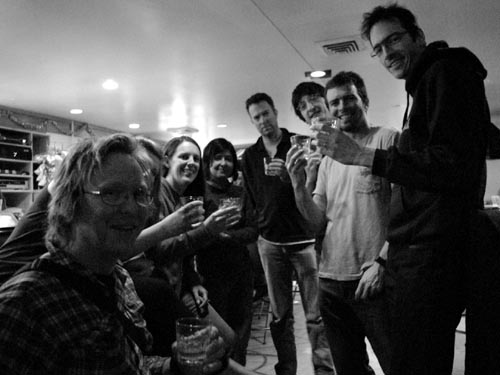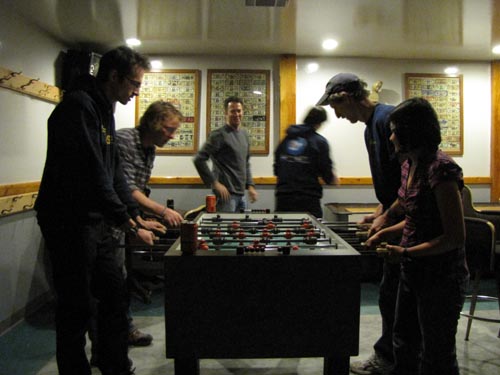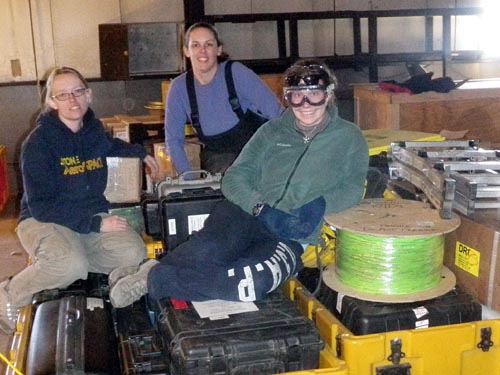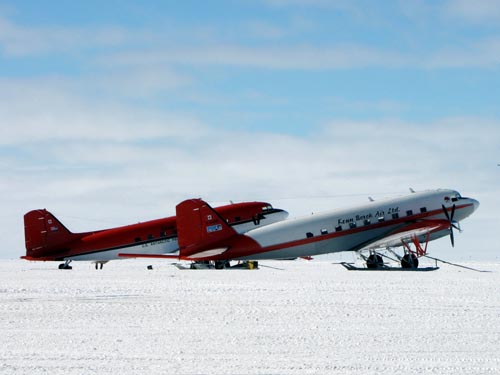Antarctica
2009
| |||||||||||||||||||||||||||||||||||||||||||||||||
| |||||||||||||||||||||||||||||||||||||||||||||||||
| |||||||||||||||||||||||||||||||||||||||||||||||||
1 December 2009
The past few days have been a whirlwind of activity (not much different from normal, I realize) as we prepare for the end of the season. To be certain, our days here have been long from the beginning. But as we begin to see the light at the end of the tunnel here, we have been stacking on extra missions and goals "because we have time" to get them accomplished. Now that we have most of the scientific data that we came here to collect, we have set our focus a little more on technology development and testing, and have decided to let the robot stretch his legs (thrusters??), as it were. One of the many things that has become a hot topic in the past few days is running a mission without the oversight of mission control. This is the ultimate goal of this technology, after all, however all on the team were not in agreement about the extent to which we should proceed, especially this late in the season. Any catastophic failure would have delayed our departure by quite a bit, not to mention just the logistical effort it would take to recover the vehicle. A compromise was reached on the difficulty and distance of the mission, and all went swimmingly well.
A fun little side activity turned promotional video of the robot going through its visual homing procedure after one of our hands-off missions. The robot's upward-facing camera seeks and locks onto the blinking light based on its frequency, and ascends the melt hole. This procedure is an important part of the robot coming up a hole that is a just a few inches larger than it is.
Meanwhile, Vickie and I are getting ready for the big pack-up effort that will begin on Thursday evening. Our departure has been pushed back until Saturday, December 5 so that we could use as much of Thursday as possible for missions. There is very little that can be packed before the robot is done, and in fact a good portion of what has to be packed is attached to the robot right now. On top of that, packing soggy robot parts is not really something we want to do (does anyone?), so we will have to thoroughly dry what we can, and wait on the rest. Antarctica is very dry, so this shouldn't take terribly long. This is a good thing, as helicopters start picking up Friday, and the roof of the bot house will be coming off soon after so the bot will be ready to fly.
We're all hoping for no weather delays, what with at least seven helo loads total, including people and science cargo. In addition to just wanting to get moving in general, I'm excited to see the science lecture on Sunday. McMurdo hosts science lectures on Sundays occasionally, for the benefit of the support staff in town. They get to find out about the various science projects they are supporting during the season. This Sunday, our Prinicipal Investigator Peter is giving the lecture, along with Bill. Peter liked the above video enough that he has decided to include it in his presentation. He has also come up with a catchy poster that will hopefully have him talking to a standing room only crowd. (It will be hard to compete with the crowd that came to see the Frozen Planet series producer from the BBC, who spoke just before we left town, so we could use the help! Heh.)

5 December 2009
Our last few days of missions have almost become, dare I say it, routine, and the team has started wishing that we had more time to get more missions in, now that we are past the start-up blues of troubleshooting problems and weather delays; at the same time, we're all looking very forward to some creature comforts such as beds, showers, and fresh fruits... and while we're at it, a little time off. You can't have it both ways, of course, and regardless our time here is up.
Not wanting to waste any free time during our dwindling days in Taylor Valley, Shilpa and I decided to go for a small excursion after a rare (our only?) 9-hour work day. She had been to the east end of the lake once before, and wanted to go back, so I tagged along. We actually took an ATV for the first part of the trip, to the end of East Lake Bonney, and we had to park quite a distance from shore, to be certain we wouldn't fall through. The moat ice is definitely starting to melt.

Running water! It's almost like it's warm! Here I am, alongside Priscu Stream, named for our project co-investigator John Priscu, who just left camp a couple of weeks ago. This stream is fed by Doran Stream, named for our pricipal investigator Peter Doran. This provides fodder for lots of jokes between them around camp, as you might imagine.

In desperate need of a break from the stressful work days and close, populated living quarters (we all are), Shilpa takes a chance to do a little Antarctic sunbathing.
This was definitely the last chance for a break, though, and packing got underway as soon as our missions were over on Thursday. One of the first things that happens once the bot is out of the water is that we take its orange syntactic floatation blocks off. We have to take about a thousand pounds off the robot for the helicopter to be able to fly with it, and these four pieces alone account for 800 of those. After that we remove the batteries and several other instruments that are too fragile to leave on the vehicle during flight.

Here's all four syntactic blocks in large yellow crates, almost ready to be closed up and prepared for helicopter sling load.

Here's the robot after all necessary parts have been removed, and his little robot cozy installed to protect him during flight. The carpenters also made us some fins for the helo flight, since the vehicle will spin uncontrollably during flight without them. Most important of all, they also gave us flames!
The next day all that was left was to take down the roof of the bot house so that the helo could get in and pick up the robot. We took the roof down with the help of a few carpenters, but the weather degenerated enough such that helo operations would only fly passengers, no external cargo. We got back to town on time (barely!) but the bot will have to wait until Monday.
Nothing very professional or flashy here, but this clip of us taking off from Bonney Camp provides a pretty good sense of scale for our surroundings, which I've found hard to capture during my time here. Towards the end of the clip you can see Taylor Glacier just over the Bonney Riegel, as well as Rhone Glacier up to the right.
I think my favorite part of the evening was dinner. All meals at McMurdo so far have left a lot to be desired, but tonight, after weeks of what seemed like nothing but carbs, frozen mixed veggies, cheddar cheese and chocolate... well very little effort was probably needed to excite me. And indeed I was plenty excited to see something as fancy as onion bread on the salad bar. But then, lo, near the cafeteria exit, was a tray of freshly roasted garlic bulbs with sprigs of roasted rosemary. I tried to eat a real meal; really I did. But garlic and rosemary it was. My stomach has shrunk up quite a bit over the course of our six stressful weeks in the field. I guess I needed as much flavor and texture as possible crammed into the smallest package. Garlic's a winner there.

After dinner, the evening turned into an impromptu celebration of a successful season, and our return to civilization. L-R: Jim, Kat (behind Jim; Raytheon employee who was sent to help us close up camp), me, Shilpa, Peter, Chris, Maciej, Kristof.
7 December 2009
Vickie and I had planned to get right to work on Sunday getting all of our gear repacked and manifested for shipment back to Texas, but since the weather prevented most of it from arriving with us on Saturday, this all but enforced a day off on us. No complaints. We certainly needed it. (The reason for the rush to work is that Maciej, Peter's grad student and all around assistant down here, determined that he could get us all bumped up to a flight to Christchurch on the 11th, instead of us taking our original flight on the 16th. This sounded doable (and quite desirable!) to all of us.)
So Sunday most of us spent at a more relaxed pace. I settled into my new room for the week, and took some time to catch up on communications with friends and family. Others decided to make a short trek down to the ice shelf to attend an open house the SCINI team was holding with their remotely operated vehicle. Kristof got to drive it, and Emma saw seals, and sounds like it was very eventful for all. Meanwhile, Peter and Bill worked on their presentation material for the Sunday Night Science Lecture, and Shilpa worked on compiling videos from some of the data ENDURANCE collected this season, so that they could be presented as well.

Peter explained some of the data that was collected this year, as well as much of what was collected last year.
Monday brought with it more weather delays, so not a whole lot of packing got accomplished today either. Peter, Shilpa, Chris, and Kristof all leave before I do, on Tuesday, so Maciej, our go-to celebration specialist, did all the required paperwork so that we could have an end-of-season party tonight. (Yes, there's paperwork for that too.) McMurdo has three bars, and all of them are closed on Mondays. So we were able to use the Southern Exposure bar as our private party venue for the night.

Amongst the many party activities for the evening was a whole lot of foosball. Shilpa blames foosball (at least in part!) for not having her Ph.D. finished yet, and she's a force to be reckoned with at the game.
10 December 2009
After a couple of days of enforced relaxation, we spent the rest of the week doing a lot of hurry up and wait, much like the beginning of the season: weather delays, equipment delays, and the challenges of working in the building they put us in for the week. Not only was it halfway up Ob Hill - even further out of town than our last locale - but it is slated for demolition in January, and for good reason.

Here is a close up of the wooden floor in the building. Both metal and wood portions of the floor bowed under just my weight. They actually expressed concern when they put us here that the robot would actually fall through the floor. But here we are nonetheless.
Our tasks for the week were not that many. We needed to put the syntactic back on the robot, and get the robot in his wooden shipping crate; we needed to get all of our instruments out of the large triwall cardboard boxes, and back into the large yellow boxes the syntactic had been flown from the field in; and we needed to separate things that needed to be back early, so that they could be shipped commercial air - everything else will arrive by ship at Port Hueneme in California sometime in March. There were a few other odds and ends, but this was the bulk of the work. The only reason for worry then was that all of these things require a lot of heavy lifting, which made us very dependent on the system here in McMurdo.
To get the robot on the floor of his crate, we of course needed a hoist and a gantry crane. We assembled this ourselves, laid out the gantry rails from the bot house (brought in just for this purpose), and arranged all our other heavy gear with the pallet jack in such a way so that we would never have to move it without the help of the hoist. This was more difficult than it sounds, because this building has random low-hanging pipes and bare-ended wires that we had to avoid.

I'm sorry (sort of!) that I don't have pictures of the many sketchy maneuvers that got the robot to his perch on the floor of the crate, but it took all hands on deck to push a 2,000-pound robot on an under-rated gantry with missing parts across a rotting, sloping floor on rails that were not attached. Wow!

Vickie, Emma, and myself after a laborious afternoon getting all these boxes and miscellany to fit into two large yellow crates. Emma is sporting the various pieces of random eyewear found during the process, including John Priscu's eyeglasses. How they got into a large triwall box, weeks after his departure, is a mystery for the ages.
Thus endeth the working part of the 2009 ENDURANCE field season! I spent the rest of today wandering around town trying to take in a few things that I hadn't had a chance to explore, and I have added a lot of pictures to the photos of town page I put up right after my arrival in McMurdo. Tonight we turn in our checked baggage, and tomorrow, if all goes as planned (and it often does not here, but let's not discuss that!), we are on a C-17 bound for Christchurch!
I spent a lot of the internet down time we had in the field putting together this video. The romanticized version of our field season, reduced to 3.5 minutes. Enjoy!
11 December 2009
!!!
Finally!! After two months in Antarctica!
What's the excitement about?? Warm weather? Fresh fruits? Privacy? Belgian beers, kebab stands, and discos? No, no, no, no... This guy!
This little adelie penguin found his way to the Pegasus Airfield, and he was not very happy when it came time for planes to land and take off.

A slightly closer view... my 20x zoom only got me this far. Not only is it against the Antarctic Treaty to go chasing penguins, I don't want a C-17 on my head.
Eighty people were dropped off by Ivan the Terrabus at Pegasus Airfield more than two hours in advance of our departure time. During that time we all shuffled around on the Ross Ice Shelf, patiently waiting for our C-17 to arrive, getting cold, getting hungry, and trying not to have to use the restroom. What a delight, nay, in hindsight, a relief it was to have our small adelie friend arrive. All were jockeying for position to get the little guy captured in photos and video, and I admit I was no different. A conflict that I assume, or hope, the others were having washed over me as I lived though this, the pinnacle of the average person's expectations of an Antarctic experience. There is so little life of any kind in Antarctica, and we still manage to interfere with all of it anyway.

These cargo loaders assumed their frequent position of wildlife deterrent. Our adelie friend was only intermittently deterred, and is hidden behind a small ridge in the ice in this photo.
Meanwhile, the planned activities of the Pegasus Airfield continued on. There are several DC-3 aircraft operated by a Canadian company flying from this field. They go to the "deep field camps" on the continent, camps that are more remote than our Dry Valleys camp. I met one of the Basler pilots earlier in the season, and he was scheduled to do the yearly "put in" of the ice runway at WAIS Divide. This involves flying in on a completely sunny day; if it's overcast, there are no shadows on the ground, and therefore no visible relief to find a smooth landing spot. The WAIS Divide project was more than a month behind schedule because of delays related to this and other weather reasons. (We thought we had it bad!)

Basler DC-3s parked at Pegasus Airfield.
Finally, though, the moment we had all been waiting for did arrive. Our C-17 from Christchurch landed, and all were ecstatic to be warm and to start the first leg of the trip home.
We still waited out in the cold about an hour after arrival for cargo unloading and reloading, but yes, we finally made it off The Ice. Christchurch, here we slowly come.
Two months in Antarctica. This has been everything I thought it would be, and certainly more. I often feel that Dominae, my friend for almost two decades now, should have come in my place, this being her ultimate destination for as long as I can remember; I feel as though I stole it from her, and in the end my prevailing memories of the experience fall into two categories: regret, and longing for more. Discretion being the better part of valor, let me end this experience by sharing with you a "video" of one of my favorite phenomena in Taylor Valley.
This is the sound of the 12-15ft ice layer on Lake Bonney cracking at "night", the time of day when the sun was blocked by mountains, and no longer warming the ice. This only happened early on in our time in the field, and Chris (and afterwards Kristof and I) referred to them as the "little ninjas".
(Headphones will probably do the audio the most justice.)